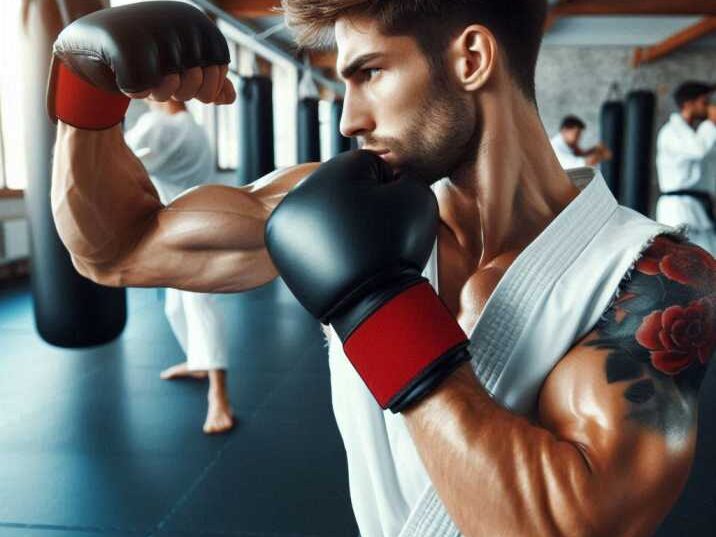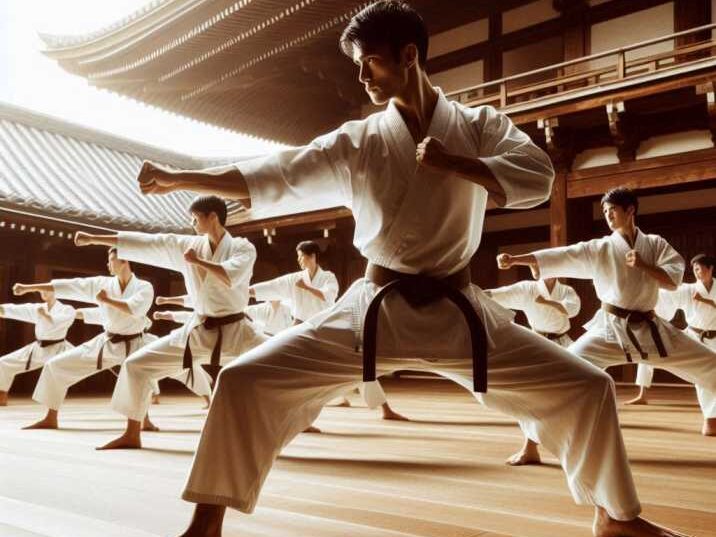Introduction
Table of Contents
Karate is a popular martial art that has fascinated people of all ages for years. You might have heard of famous karate moves like the punch or the kick, but did you know that karate involves many more techniques than just that? In fact, karate has hundreds of moves, each serving a different purpose. These moves, called karate techniques, are designed to teach control, strength, and discipline.
In this article, we’ll break down the essential karate moves, explain how many there are, and why they are important. Whether you’re just starting or curious to learn, this guide will give you a better understanding of karate and how it can help improve focus and discipline!

What Are Karate Moves?
Karate moves, also called techniques or kata, are the actions you perform in karate training or practice. These techniques include blocks, punches, kicks, and stances. In total, there are around 26 formal kata in traditional karate, each with a series of moves that a karateka (karate practitioner) must master. But when we break it down into individual techniques, there are hundreds of moves in total.
Categories of Karate Moves
Karate moves can be categorized into several types, each serving a different purpose in training and combat. Here are the main categories:
- Kihon (Basics)
- Kata (Forms)
- Kumite (Sparring)
- Atemi Waza (Striking Techniques)
- Uke Waza (Blocking Techniques)
- Dachi (Stances)
- Nage Waza (Throwing Techniques)
1. Kihon (Basics)
Kihon refers to the essential techniques that form the foundation of karate. These are the building blocks that every karate student must master before advancing to more complex techniques. Kihon includes four key components: punches, kicks, blocks, and stances. Here’s a brief explanation of each:
- Punches (Tsuki):
- Choku Tsuki (Straight Punch): A direct, straight punch aimed at the opponent’s torso or face.
- Oi Tsuki (Lunge Punch): This punch involves stepping forward while punching, adding more force and distance.
- Gyaku Tsuki (Reverse Punch): A punch thrown with the hand opposite the leading foot, often used in combination with blocks for counter-attacks.
- Kicks (Geri):
- Mae Geri (Front Kick): A basic forward kick aimed at the opponent’s stomach or chest.
- Mawashi Geri (Roundhouse Kick): A circular kick aimed at the sides of the opponent, targeting the head, ribs, or legs.
- Yoko Geri (Side Kick): A powerful kick delivered from the side, often aimed at the opponent’s midsection or knees.
- Blocks (Uke):
- Age Uke (Upper Block): Used to block strikes coming towards the head.
- Chudan Uke (Middle Block): A block that defends the torso from strikes.
- Gedan Barai (Lower Block): A sweeping block used to deflect low attacks, such as kicks to the legs.
- Stances (Dachi):
- Zenkutsu Dachi (Front Stance): A strong forward stance with the front leg bent and back leg straight, used for both attacking and defensive moves.
- Kokutsu Dachi (Back Stance): A more defensive stance with weight shifted to the back leg.
- Kiba Dachi (Horse Stance): A wide, low stance that provides balance and stability, often used for practicing strikes and blocks.
2. Kata (Forms)
Kata are choreographed sequences of movements that represent a fight against imaginary opponents. Each kata has a specific pattern and rhythm, and students must memorize and perform these movements precisely. Practicing kata helps develop muscle memory, balance, coordination, and timing.
- Heian Shodan: This is one of the first kata learned by beginners, featuring simple moves that help students understand basic strikes, blocks, and stances.
- Tekki Shodan: This kata emphasizes strong stances and is practiced to build strength and stability in close-range defense.
- Bassai Dai: A more advanced kata, Bassai Dai focuses on powerful strikes and aggressive blocking techniques, preparing students for more complex challenges in karate.

3. Kumite (Sparring)
Kumite is the practice of sparring or fighting against a real opponent. In kumite, students apply the techniques learned in Kihon and Kata in a dynamic and controlled environment. Kumite is essential for developing timing, distance, and the ability to react quickly in a fight. There are different types of kumite depending on the level of the student:
- Jiyu Kumite (Free Sparring): In this form of kumite, students spar freely, using any techniques they have learned. It allows them to practice offense and defense in real-time.
- Yakusoku Kumite (Pre-arranged Sparring): Here, the sparring follows a predetermined sequence of attacks and defenses. It’s more structured and helps students focus on technique and timing.
- Ippon Kumite (One-Step Sparring): One practitioner attacks with a single decisive move, while the other defends. This practice builds the ability to anticipate and react to an opponent’s attack with precision.
4. Atemi Waza (Striking Techniques)
Atemi Waza refers to all striking techniques in karate, including punches, kicks, elbow strikes, and knee strikes. These offensive moves are essential for attacking an opponent effectively. Each technique in Atemi Waza must be performed with timing, accuracy, and power to be effective in both self-defense and sparring situations.
- Seiken Tsuki (Forefist Punch): This is a basic punch that uses the front two knuckles to strike an opponent’s target, typically aimed at the torso or face. It is one of the most fundamental and frequently used punches in karate.
- Shuto Uchi (Knife Hand Strike): The edge of the hand is used in a chopping motion to deliver a precise strike. This technique is often aimed at vulnerable areas like the neck or temple, making it a powerful move when executed correctly.
- Hiza Geri (Knee Strike): This is a close-range strike using the knee, typically aimed at the opponent’s midsection or head. The Hiza Geri is an incredibly strong technique, particularly useful when grappling with an opponent.
5. Uke Waza (Blocking Techniques)
Uke Waza consists of the various blocking techniques used in karate to defend against strikes, kicks, or other attacks. Blocks are crucial for protecting vital parts of the body and creating opportunities to counterattack. Each block serves a unique purpose depending on the direction and type of attack.
- Age Uke (Rising Block): This block is used to defend against strikes aimed at the head, such as punches or overhead weapons. It involves raising the forearm above the head to intercept and deflect the attack.
- Soto Uke (Outside Block): This block protects against attacks coming from the side, typically targeting the torso. The arm moves outward to intercept the attack, pushing it away from the body.
- Gedan Barai (Downward Block): A sweeping block used to deflect low kicks or strikes, usually aimed at the legs or midsection. The arm moves in a downward arc to redirect the attack away from the body.
6. Dachi (Stances)
Dachi refers to the various stances used in karate to provide a stable base for executing techniques. Each stance helps the practitioner maintain balance and control during attacks and defenses. Without proper stances, movements lack power and precision.
- Zenkutsu Dachi (Front Stance): This long stance allows for powerful forward attacks and is commonly used in both basic techniques and kata. The weight is distributed towards the front leg to provide momentum for strikes.
- Kokutsu Dachi (Back Stance): A defensive stance where the weight is placed on the back leg, allowing for quick retreats and defensive moves while keeping balance and readiness for counterattacks.
- Kiba Dachi (Horse Stance): A wide, low stance that offers strong stability, often used to practice strikes, blocks, and transitions in kata. This stance builds strength in the legs and core.
7. Nage Waza (Throwing Techniques)
Nage Waza includes throwing techniques that are used to unbalance and take down an opponent. Although not as common in traditional karate as in martial arts like Judo or Aikido, certain karate styles incorporate throws into their curriculum.
- O Soto Gari (Major Outer Reap): This throw involves sweeping the opponent’s leg while pushing their upper body backward, forcing them to fall to the ground.
- Seoi Nage (Shoulder Throw): In this technique, the practitioner pulls the opponent over their shoulder and throws them to the ground. It’s a powerful move that uses leverage rather than strength to overcome an opponent.
How Many Karate Moves Are There in Total?
It’s hard to give an exact number of karate moves because there are so many styles, each with its own variations of techniques. However, if we count all the basic punches, kicks, blocks, stances, and throws, there are over 200 different moves in karate. Advanced practitioners often learn even more as they progress through higher ranks, learning specialized kata and kumite techniques that further expand their knowledge and skills.
Benefits of Learning Karate Moves
Training in karate offers many benefits that go beyond self-defense. Here are some of the most important advantages:
- Improved Focus and Discipline: Karate requires intense concentration and discipline during practice. These skills can translate into better focus in school, sports, and other areas of life. The mental discipline learned in karate helps students stay focused and persevere through challenges.
- Physical Fitness: Karate is a full-body workout that helps improve strength, flexibility, endurance, and overall fitness. It’s a great way to stay active and healthy while learning valuable self-defense skills.
- Confidence: As students learn to defend themselves and master challenging techniques, they gain a sense of confidence. Knowing that you can protect yourself builds self-esteem and encourages positive self-image.
- Coordination and Balance: Practicing karate moves requires precise coordination of the body. Over time, this practice improves balance, coordination, and body control, which can benefit other physical activities as well.
- Respect and Self-Control: Karate emphasizes respect for teachers, fellow students, and oneself. Practitioners are taught to be calm and controlled, both in their movements and their emotions. This respect and self-control extend to everyday life, teaching valuable life lessons.
Table of Karate Moves
| Category | Moves |
|---|---|
| Kihon (Basics) | Punches, Kicks, Blocks, Stances |
| Kata (Forms) | Heian Shodan, Tekki Shodan, Bassai Dai |
| Kumite (Sparring) | Jiyu Kumite, Yakusoku Kumite, Ippon Kumite |
| Atemi Waza (Strikes) | Seiken Tsuki, Shuto Uchi, Hiza Geri |
| Uke Waza (Blocks) | Age Uke, Soto Uke, Gedan Barai |
| Dachi (Stances) | Zenkutsu Dachi, Kokutsu Dachi, Kiba Dachi |
| Nage Waza (Throws) | O Soto Gari, Seoi Nage |
Conclusion: Karate is More Than Just Moves
Karate has hundreds of moves, from punches and kicks to stances and blocks. Each move helps students develop their skills and teaches valuable lessons about concentration and discipline. Whether you’re learning to defend yourself, improve your strength, or just have fun, karate offers something for everyone. And as you practice, you’ll discover that karate isn’t just about fighting—it’s about learning how to focus your mind and body!
FAQs
1. How many karate moves are there?
There are hundreds of karate moves, but they are grouped into 26 official kata with various punches, kicks, and blocks.
2. What is the easiest karate move to learn?
The front kick (Mae Geri) and the lunge punch (Oi Tsuki) are some of the easiest moves to learn.
3. Can kids learn karate moves?
Yes, karate is great for kids! It helps them stay active, learn discipline, and have fun.
4. How long does it take to master karate moves?
It can take years to master karate moves, but students can start learning the basics within a few months.
5. What are the benefits of learning karate?
Karate improves focus, builds strength, teaches self-defense, and helps with discipline.


